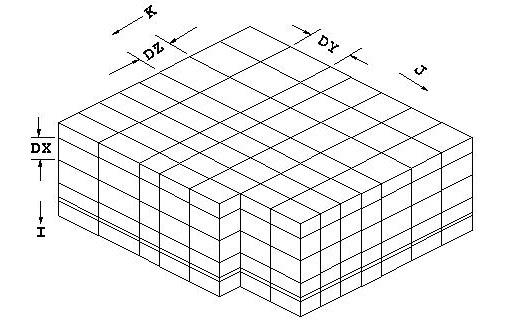| Simulator Characteristics
IPARS supports three dimensional transient
flow of multiple phases containing multiple components plus
immobile phases (rock) and adsorbed components. The nonlinear
partial differential equations describing flow are solved
by cell-centered finite-difference methods in the current
version of the simulator but the use of finite-element methods
in future versions is not excluded.
Phase densities and viscosities may be arbitrary
functions of pressure and composition or may be represented
by simpler functions (e.g. constant compressibility). Actual
treatment of phase properties depends on the physical model.
Porosity (at standard conditions) and permeability
may vary with location in an arbitrary manner. Some physical
models treat porosity as a constant and others make it a function
of pressure. Permeability is currently a constant diagonal
tensor but provision is made for using a full tensor.
Relative permeability, and capillary pressure
are functions of saturations and rock type. Rock type is a
function of location. Several models for three-phase relative
permeability are built into the simulator and other models
can be added as needed. Any dependence of relative permeability
and capillary pressure on composition and pressure is left
to the individual physical models.
IPARS provides a general x-y function capability
that is widely used in the physical models to represent various
properties; the options in this capability include:
1. Piecewise constant
2. Piecewise linear
3. Quadratic spline with optional poles
4. Cubic spline with optional poles
5. User define functions (FORTRAN code in the input data)
Yes, the simulator includes a built-in compiler which can
be convenient when one wants to use an analytic function to
represent, say, the dependence of relative permeability on
water saturation.
The reservoir consists of one or more fault
blocks. Each fault block has an independent user-defined coordinate
system and gravity vector. Flow between fault blocks can occur
wherever fault blocks share a common face. The primary grid
imposed on each fault block is a logical cube but may be geometrically
irregular. Grid elements may be keyed out to represent irregular
shapes and impermeable strata. The grid may also be distorted
to represent curved formations; the small-angle approximation
is used for this purpose.
The simulator currently supports three-dimensional
rectangular Cartesian grids in most cases. There are capabilities
to execute two-phase flow simulations on unstructured grids
using discontinuous Galerkin methods. A simple grid for a
single fault block is illustrated in Fig. 1. Two columns of
grid elements have been keyed out in the figure to demonstrate
a method that can be used to represent irregularly shaped
reservoirs or aquifers. Multiple fault with independent grids
may also be specified. Flow can occur between fault blocks
that share a common surface. This surface does not have to
be parallel to a coordinate plain but may instead be formed
by keying out elements in the two blocks. The name "fault
block" is somewhat misleading; there are other uses for
the IPARS geometric capability. One may, for example, key
out a column of elements containing a well and replace the
column with a "fault block" having a finer grid.
To take the process one step farther, one might also specify
the black-oil for the inner fault block and the two-phase
model for the outer fault block.
On multiprocessor machines, the grid system
is distributed among the processors such that each processor
is assigned a subset of the total grid system. The subgrid
assigned to a processor is surrounded by a "communication"
layer of grid elements that belong to other processors. The
framework provides a routine that updates data in the communication
layer.
IPARS supports an arbitrary number of wells each with one
or more completion intervals. A well may penetrate more than
one fault block but a completion interval must occur in a
single fault block. On parallel machines, well grid elements
may be assigned to more than one processor. For each well
element, the framework provides estimates of the permeability
normal to the wellbore, the geometric constant in the productivity
index, and the length of the open interval. Other well calculations
are left to the individual physical models.
Portability of the simulator is emphasized.
FORTRAN77 and classical C code are used. Manufacturer specific
language enhancements are prohibited. Commercial libraries
are also prohibited except in the graphics area.

A Simple IPARS Grid
A restart capability is included in IPARS.
The restart file(s) are independent of the number of processors
and may be written in either binary or ASCII format. An ASCII
file is much larger than the same file written in binary but
can be moved between machines and operating systems.
Free-form keyword input is used by the simulator.
The input file can be prepared with any editor capable of
producing an ASCII file. Much of this manual is devoted to
defining keyword variables.
Multiple levels of output are provided in
the simulator. These range from selective memory dumps for
debugging to minimal output for automatic history matching.
Every output statement in the simulator is assigned an output
level. The simulator will not, repeat not, dump all results
between time steps so that the user can choose any output
he pleases after the simulation.
Internally the simulator uses a single set
of units for each physical model. Externally, the user may
choose any physically correct units he pleases; if he wants
to specify production rates in units of cubic furlongs per
fortnight, the simulator will determine and apply the appropriate
conversion factor. The simulator does provide a default set
of external units for each physical model. |

